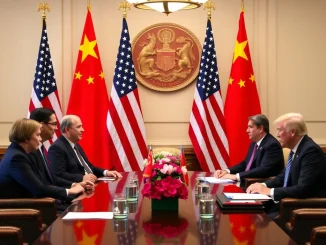
Buckle up, crypto enthusiasts and market watchers! A significant development in global trade is about to unfold, and it could ripple through all markets, including the crypto sphere. President Trump’s executive order on reciprocal tariffs is no longer just talk – it’s becoming reality. Get ready for US tariffs to officially kick in, starting with base tariffs on March 5th and escalating with country-specific rates from March 9th, according to reports from Odaily News. What does this mean for you, and how might it reshape the economic landscape?
What’s Happening with the New Trade Tariffs?
Let’s break down this developing situation into digestible points. The core of the matter is the implementation of Trump tariffs, a policy initiative focused on ‘reciprocal tariffs varying by country’. Here’s what you need to know:
- Executive Order Signed: President Trump has formalized his stance on trade with an executive order, paving the way for new tariffs.
- Two-Phase Rollout: The implementation isn’t happening all at once. It’s structured in two phases:
- Phase 1 (March 5th): Base tariffs will be enforced. Think of these as the initial, broader tariffs affecting a range of imports.
- Phase 2 (March 9th): Country-specific tariffs will be introduced. This suggests targeted tariffs aimed at particular nations, likely based on trade imbalances or specific trade practices.
- Source: This news originates from Odaily News, indicating it’s circulating within financial and economic news circles.
In essence, the US is taking a decisive step in its trade policy, moving from rhetoric to action. But what are the potential implications of these global trade shifts?
The Potential Economic Impact: Ripple Effects Across Markets
Tariffs are not isolated events; they have a cascading effect. When a major economy like the US imposes tariffs, the repercussions are felt worldwide. Here’s a glimpse at the potential economic impact:
- Increased Import Costs: The most direct effect is on import prices. Tariffs are essentially taxes on imported goods, making them more expensive for US businesses and consumers.
- Retaliatory Tariffs: Other countries may retaliate by imposing tariffs on US exports. This could trigger trade disputes and potentially a trade war, impacting various sectors.
- Supply Chain Disruptions: Businesses with global supply chains might face disruptions as they adjust to the new tariff regime. This could lead to increased costs and delays.
- Inflationary Pressures: Higher import costs can contribute to inflation, as businesses may pass on these costs to consumers.
- Market Volatility: Uncertainty surrounding trade policies can create volatility in financial markets, including stock markets and potentially cryptocurrency markets.
Could Crypto Be Affected? While not directly targeted, the cryptocurrency market isn’t immune to broader economic shifts. Here’s how:
- Risk-On/Risk-Off Sentiment: Global economic uncertainty often drives investors towards safe-haven assets or away from riskier ones. Depending on market perception, crypto could be seen as either a risk-on or risk-off asset in this context.
- Dollar Strength/Weakness: Trade policies can influence the strength of the US dollar. Dollar fluctuations can, in turn, impact the price of Bitcoin and other cryptocurrencies, often priced against the dollar.
- Inflation Hedge Narrative: If tariffs contribute to inflation, Bitcoin’s narrative as an inflation hedge could gain traction, potentially increasing demand.
- Broader Market Sentiment: A downturn in traditional markets due to trade tensions could spill over into the crypto market, at least in the short term.
Navigating the US Tariffs Landscape: What to Watch For?
Staying informed is crucial. Here’s what you should be keeping an eye on:
- Official Announcements: Monitor official statements from the US government and trade bodies for detailed information on the tariffs – specific goods affected, country-specific rates, and any exemptions.
- Market Reactions: Observe how traditional financial markets and the cryptocurrency market react to the tariff implementations on March 5th and March 9th. Volatility could present both risks and opportunities.
- Company Responses: Pay attention to how major companies, especially those involved in international trade, respond to the tariffs. Their strategies and statements can provide insights into the real-world impact.
- Geopolitical Developments: Trade policy is intertwined with geopolitics. Watch for any diplomatic responses or retaliatory measures from other countries, as these can further shape the economic landscape.
Final Thoughts: Preparing for the Trade Tariffs Era
The implementation of US tariffs marks a significant shift in global trade dynamics. While the full economic impact remains to be seen, it’s clear that businesses and investors need to be prepared for potential changes and volatility. For the crypto market, this adds another layer of complexity to an already dynamic environment. Staying informed, understanding the potential ripple effects, and adapting your strategies will be key to navigating this evolving economic landscape. Keep a close watch on March 5th and March 9th – these dates could mark the beginning of a new chapter in global trade and its influence on all markets, including the world of cryptocurrency.



